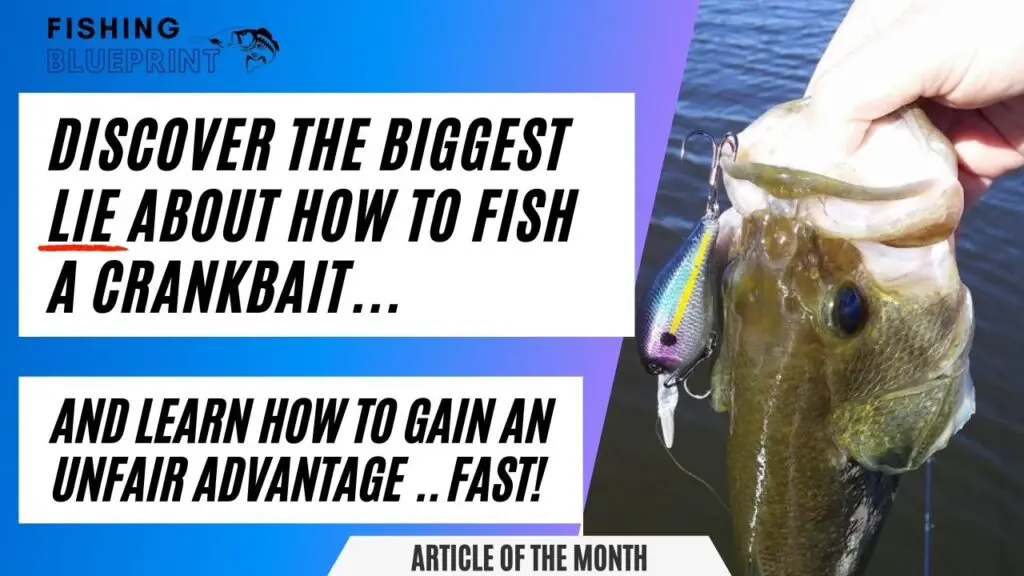How To Fish Kinnikinick Lake
Kinnikinick Lake Fishing Report
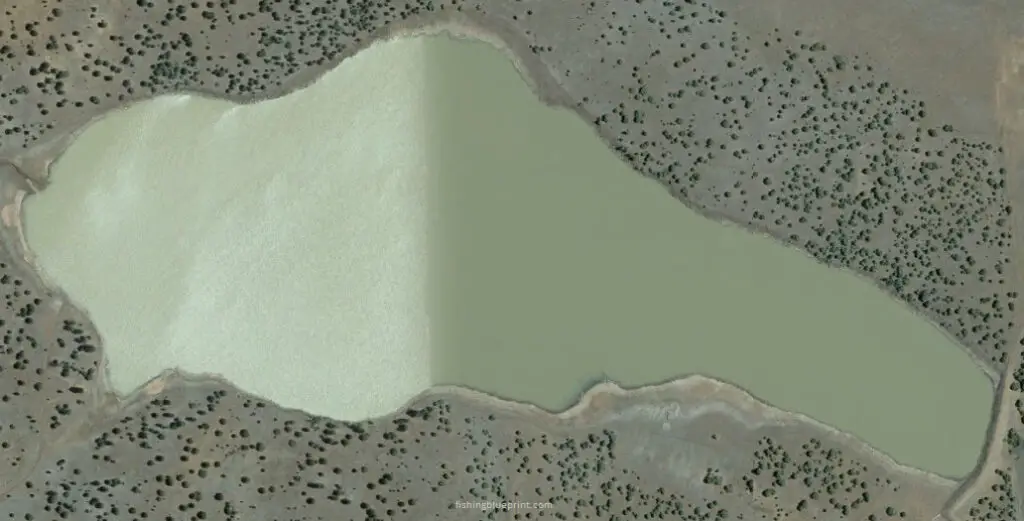
Kinnikinick Lake is a small lake just south of Flagstaff, Arizona, making it 157 miles from Phoenix, Arizona.
Overall it’s a popular lake especially on the weekends and during the summer. In this post you’re going to be given the blueprint to fish this lake.
So what are the best tips for fishing Kinnikinick Lake? There are three important factors you must know if you want to know how to fish Kinnikinick Lake successfully. First, you need to know what kind of fish is in Kinnikinick Lake. Second, it’s important for you to know which part of the lake each species can be found. Lastly, knowing what are the best baits that work on Kinnikinick Lake is vital. However, tactics, baits, and locations will be different for each type of fish that you target. So let’s talk about the steps you need to take in order to give you the best chance of catching a fish on Kinnikinick Lake.
WARNING: There’s a lot of information about this subject you’ll probably want to come back to. No one expects you to remember all these tips. We know your time is precious, so we really tried to over-deliver in value for you. Additionally, we frequently update reports like this, so you’ll want to stay up to date with any changes or additional tips we include for you.
We found that the easiest way to save and bookmark this report so you can come back to it later is to share it on your favorite social media platform, especially if you use your phone to get important tips like the ones in this report here…
Click on your favorite social media buttons to remember this page now!
Important Lake Warnings
Algae blooms may be present which may affect fishing, swimming, and water contact in general.
Maximum 10-HP for gas engines on the lake.
If you are fishing and camping, fire bans may be in effect due to the ongoing drought conditions.
How To Catch Fish In Kinnikinick Lake
- Rainbow Trout
- Brook Trout
- Tiger Trout
- Northern Pike
- Sunfish
- Catfish
Kinnikinick Lake Fishing Tips & General Strategies
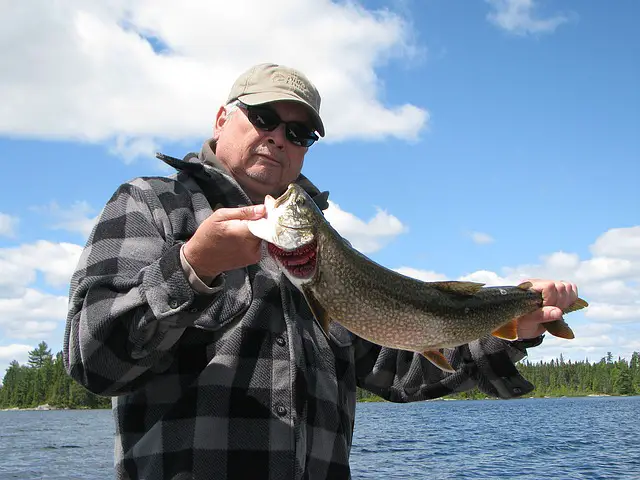
This lake is extremely popular for trout anglers due to the cold waters of Kinnikinick Lake provides. For the dedicated trout fisherman, the lake is frequently stocked with rainbow, brown, and brook trout.
It can be a challenge to break down Kinnikinick Lake and decide to get started.
Getting started, Kinnikinick Lake is a stained-to-dirty water lake, and thus fishing can be tough.
There are two primary types of fishing structures in Kinnikinick Lake; hard structures and vegetation. The hard structure consists of boulders, rock piles, ledges, hardwood timber (either in the form of laydowns or vertical timber), man-made chunk rock banks, docks and water retention dams. Despite being a high altitude mountain lake there is an abundant amount of vegetation that grows in this lake in the form of submerged grass beds, reed patches, and sometimes even floating vegetation mats.
Kinnikinick Lake is considered a highland lake and therefore shaped like a bowl. It offers short points that can drop into deeper water.
Trout can be found up shallow in the winter and spring. However, trout will often suspend over deep water and more importantly in water temperatures that range from 55.5-56.5-degrees (which is typically around 40-50-feet deep).
Trout can be caught from shore, or by boat, kayak, or float tube.
Your best chance of catching deep suspending rainbow trout is by trolling a lure behind your boat or kayak.
>> Learn More – If you want to learn more about how to troll for trout – click HERE
You can troll without a downrigger if the trout are holding higher in the water column, or you can troll your lure with a quality downrigger if you observe the trout holding in deep water.
Deeper area with chunk rock ranging from baseball to basketball size will attract predatory fish like sunfish and catfish because it provides a safe area the prey (crayfish, bream, and minnows) can hide.
If you’re interested in learning how to fish for bass there is an article that dives into that exact topic.
Fishing for Northern Pike at this lake can be a riot! Depending on how one views the circumstance, this is either beneficial or negative.
Pike have a strong appetite. Fast-moving lures that replicate other fish species are usually effective for pike. Baits that simulate rainbow trout are becoming increasingly popular at Fool Hollow, and they work well on larger fish.
For pike, don’t be afraid to toss lures that are 8″ to 10″ long.
The secret is to experiment with a variety of baits until you find one that works, and then stay with it until you no longer get strikes.
But where are the best places to fish At Kinnikinick Lake?
And in no particular order here is that list of the best fishing spots at Kinnikinick Lake.
DISCLAIMER: The material provided is for general information purposes only. It’s important to understand that any information provided in this article can change at any time. Any maps or graphics featured are not to be used as navigational aids. Fishing Blueprint will not be responsible for any personal injury or property damage from any misuse of the maps or graphics provided. It’s completely impossible to give you every single spot where you can potentially catch a fish. But, what this list does do is to give you a helping hand and narrow down to the most productive fishing spots.
Kinnikinick Dam
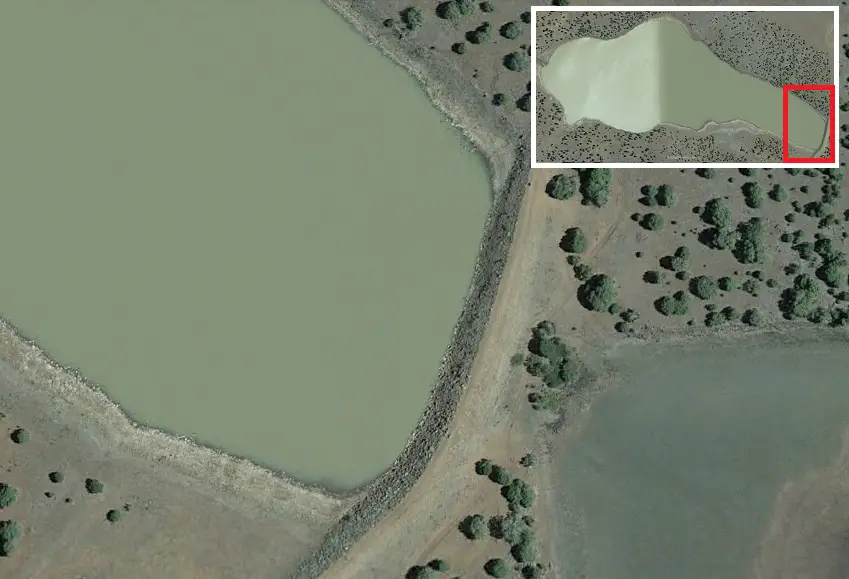
Fishing near the dam gives you ample opportunity to target rocky structure catch trout and pike.
This section of the lake can get very windy. And even with the best trolling motor, the wind can quickly blow you off your spot which will significantly decrease your chances of catching a fish.
That is why we strongly suggest buying a quality drift sock. For those who don’t know, a drift sock is like a parachute for the water. If it’s breezy to windy, you need to slow your drift otherwise your lure will not be in the strike zone long enough to catch a fish.
By the way, we found a really good quality drift sock made by Mythik Outdoors, and best of all they’re sold on Amazon.com. Go here to learn more about drift socks and read the reviews from actual customers.
Some of the effective baits for this area include:
But wait! Before you tie on any bait nearly every professional fishing guide will strongly encourage the use of a fish attractor like a quality flasher or dodger 2-3 feet in front of any lure. This helps get the fish’s attention, kinda like ringing a dinner bell!
Trolling spoons such as a Krocodile spoon, Super Duper, Crippled Herring, Cast Champ, or Hus-Lure. Trolling spoons have an unpredictable, minnow-like motion that delivers bone-crushing strikes. Even the slowest current brings these lures to life. Add extra motion by twitching the rod tip and enabling the bait to pop and dart forward and flutter back.
Inline spinners such as the Bang-Tail and Shyster are non-twist spinners that boast an immediate spin blade design for incredibly rapid start-ups and the best slow retrieve performance.
Many anglers also place their confidence in the Blue Fox Classic Vibrax inline spinner. This little bait is a compact shallow running lure that performs best in 2 to 6 feet of water, depending on the speed of the retrieve or trolling speed. The patented two-part body emits low-frequency sound vibrations that attract fish. This lure is best used in lakes, rivers, and streams.
Minnow style baits also work very well either cast-and-retrieved or trolled. These perform best if the water is clear/slightly stained. The Luhr-Jensen Quick Fish and the Rapala BX minnow are constructed from hard plastic, have a wide wobble action, and are extremely durable. Whereas the Rapala Original Floating Minnow and the Ultra Light Minnow (all are slow sinking) both give you a tighter wobble perfect for clear water and pressured fishing conditions.
Better yet, just buy a complete done-for-you trout lure kit!
Now if you’re fishing from the shore, kayak, or even from the shore you should also consider using these additional baits:
- Real or artificial corn – great because it will never spoil or mold over
- Natural salmon eggs – it’s hard to beat natural salmon eggs when trout are eating salmon eggs, they’ll eat up jars of this stuff!
- Artificial salmon eggs – great because they float off the bottom – ideal in rocky or grassy conditions
- Real worms – such as meal worms or nightcrawlers
- Artificial worms – great for trolling and will never die)
- Dough bait – great because they stay on the hook really well, it floats if you put enough on the hook, comes in a variety of colors and scents.
- Wet flies (sinking flies) – Wet flies imitate insects that develop and inhabit below the water level before emerging and rising to the surface.
- Woolly bugger flies – One of the most popular fly patterns ever is the Woolly Bugger. These mimic small fish, leeches, larvae, and worms.
.
Oh, before I forget, did you know that there is an article about how to troll for salmon, trout, and kokanee the right way? Go here to find out more.
Effective baits for bass and northern pike this area include: topwater lures, buzzbaits, frog lures, crankbaits, soft plastic swimbaits, spinnerbaits, jerkbaits, chatterbaits, swim jigs, hair jigs, and underspin jigs when the bass are aggressive. Smaller jigging spoons work great in the deeper channel sections and above any vertical timber as well.
Located: north end of the lake
Structural features: deep open water, chunk rock banks on the sides of the dam.
Best species to target: trout, walleye, northern pike, smallmouth bass, crappie, catfish, bluegill
Most effective way to fish this spot: Boat, kayak, float tube, shoreline
Steep Banks
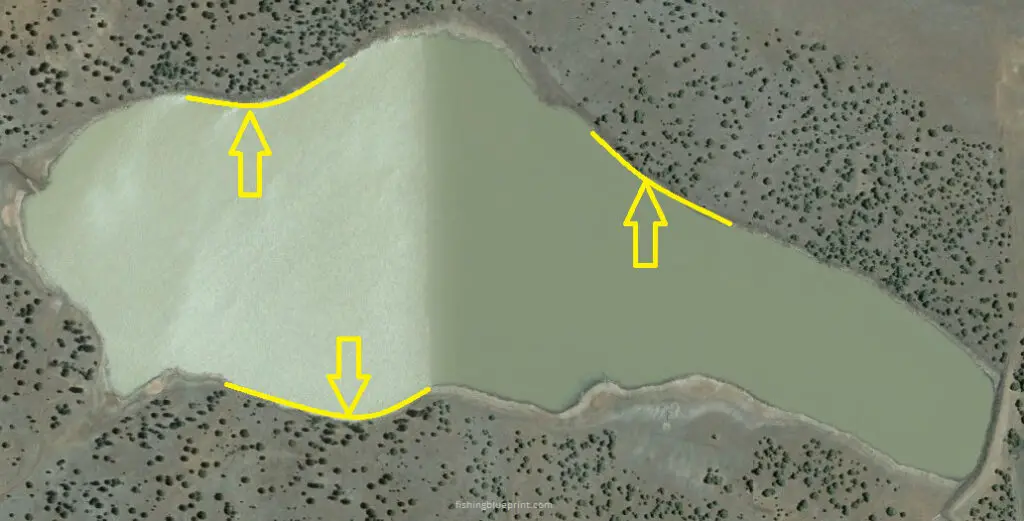
Look Closely…
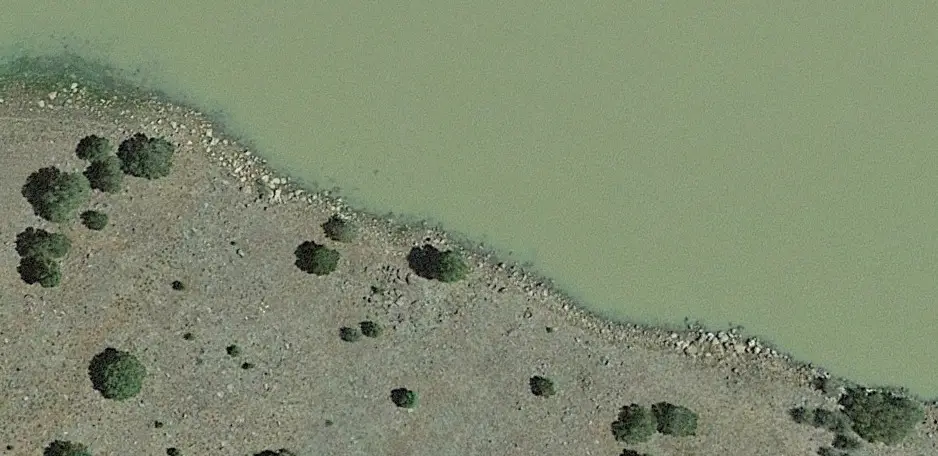
These spots marked on the map are excellent summertime fishing spots. They’re so good because nearly off the points will drop into deep water. Trout are more easily caught in deep water.
So if you’re fishing off the bank you need your bait presented in the deepest water you can cast to, and these points can get you there.
Another helpful tip is you’ll have the easiest time catching trout 45 minutes before and after sunrise and sunset. However, trout will feed all throughout the day if given the opportunity.
The banks are filled with isolated patches of chunk rock banks. They can range from moderate to relatively steep and can range from large boulders, to chunk rock, to pea-sized substrate.
Side scanning this area for active fish such as all species of trout and pike should be a must if you plan to fish this area.
The lake’s only small dry launch boat “ramp’ is located here.
Not surprisingly, this area remains relatively busy for recreational fishing traffic. However, this is also where they stock fish all throughout the summer giving anglers a better chance of catching a trout if you fish in this area.
Some of the effective baits for this area include: Fish attractor (ie: flasher or dodger), trolling spoons, inline spinners, Rapala minnows, Quick Fish, streamers and flies. You can also use real or artificial corn, natural salmon eggs, artificial salmon eggs, real worms such as meal worms or nightcrawlers, artificial worms, and dough bait. Better yet, just buy a complete done-for-you trout lure kit!
Effective baits for northern pike this area include: topwater lures, buzzbaits, frog lures, crankbaits, soft plastic swimbaits, spinnerbaits, jerkbaits, chatterbaits, swim jigs, hair jigs, and underspin jigs when the bass are aggressive. Smaller jigging spoons work great in the deeper channel sections and above any vertical timber as well.
Located: west end of the lake
Structural features: chunk rock banks that drop into deep water.
Best species to target: trout, northern pike, catfish, sunfish
Most effective way to fish this spot: Boat, kayak, float tube, shoreline
Shallow Banks

Inside coves are great fishing spots in the spring, late fall, and winter.
When the water is cooler, the trout feel more comfortable near the surface. Furthermore, they will often hunt in the shallow coves looking for insects and small fish to feed on.
Some of the effective baits for this area include: Fish attractor (ie: flasher or dodger), trolling spoons, inline spinners, Rapala minnows, Quick Fish, streamers and flies. You can also use real or artificial corn, natural salmon eggs, artificial salmon eggs, real worms such as meal worms or nightcrawlers, artificial worms, and dough bait. Better yet, just buy a complete done-for-you trout lure kit!
Effective baits for northern pike this area include: topwater lures, buzzbaits, frog lures, crankbaits, soft plastic swimbaits, spinnerbaits, jerkbaits, chatterbaits, swim jigs, hair jigs, and underspin jigs when the bass are aggressive. Smaller jigging spoons work great in the deeper channel sections and above any vertical timber as well.
Located: west end of the lake
Structural features: chunk rock banks that drop into deep water.
Best species to target: trout, northern pike, catfish, sunfish
Most effective way to fish this spot: Boat, kayak, float tube, shoreline
What Kind Of Fish Are In Kinnikinick Lake
Rainbow Trout
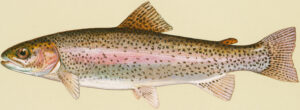 Arizona Game & Fish Department grow and stocks local lakes and reservoirs like this lake with Rainbow Trout.
Arizona Game & Fish Department grow and stocks local lakes and reservoirs like this lake with Rainbow Trout.
Due to this lake being relatively unpressured, deep, and colder, and most other desert reservoirs, the stocked trout do very well.
Since the trout are produced in local fisheries, they are healthy and have no limit on the amount of trout that can be consumed.
Typically trout are stocked twice a week, however, it can vary.
General Trout Details
Spawn: March-May
Food: insects and crustaceans.
Arizona State Record: 15 lb. 9.12 oz. 32.5 in., Willow Springs Lake Harold Wright, Sun City 9/29/06
Table Quality: Depending on the fishes diet, the meat can be white to orange-red in color. The meat is firm, flaky, and is considered excellent eating.
Angling techniques:
- Trolling with or without downriggers
- Fish attractor such as a flasher or a dodger – great when trolling.
- Trolling spoons such as a Krocodile spoon, Super Duper, Crippled Herring, Cast Champ, or Hus-Lure – simple, easy to use, can be trolled or cast-retrieved at any speed.
- Inline spinners such as the Bang-Tail and Shyster – gets a ton of bites.
- Minnow style baits such as the Luhr-Jensen Quick Fish and the Rapala BX minnow – known to hook up giant fish.
- Real or artificial corn – great because it will never spoil or mold over.
- Natural salmon eggs – it’s hard to beat natural salmon eggs at bait. When trout are eating salmon eggs, they’ll eat up a couple of jars in less than an hour!
- Artificial salmon eggs – great because they float off the bottom – ideal in rocky or grassy conditions.
- Real worms – such as meal worms or nightcrawlers.
- Artificial worms – great for trolling and will never die.
- Dry flies (floating flies) – The insects that land, float, or live on top of the water, which are represented by dry flies. Investing in a kit gives you a wide assortment of flies and a good selection of types and sizes allow you to quickly adjust to any situation.
- Wet flies (sinking flies) – Wet flies imitate insects that develop and inhabit below the water level before emerging and rising to the surface. Investing in a kit gives you a wide assortment of flies and a good selection of types and sizes allow you to quickly adjust to any situation.
- Woolly bugger flies – One of the most popular fly patterns ever is the Woolly Bugger. These mimic small fish, leeches, larvae, and worms. Investing in a kit gives you a wide assortment of flies and a good selection of types and sizes allow you to quickly adjust to any situation.
Steamer flies – They can also mimic larger animals found in streams and rivers, including crawfish, larger leeches, and smaller fish. Investing in a kit gives you a wide assortment of flies and a good selection of types and sizes allow you to quickly adjust to any situation.
- **The number one key to successful trout fishing, is to use light line (2 to 6 pound) and small hooks (10-14 sizes), and small sinkers
Brook Trout
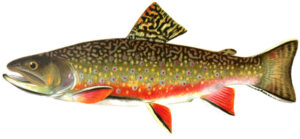 Brook trout are the only fish in Arizona with a vermiculate appearance on their backs and upper sides that appears wavy, almost worm-like.
Brook trout are the only fish in Arizona with a vermiculate appearance on their backs and upper sides that appears wavy, almost worm-like.
They have red specks encircled by blue halos and are olive-green to olive-brown in color, with reddish tints.
Pectoral, pelvic, and anal fins with white-leading edges are the most prominent features of a brook trout.
Brook trout are opportunistic eaters who eat tiny crawfish, worms, minnows, and terrestrial and aquatic invertebrates.
They eat whatever is accessible to them. Anglers love them because they can accept a variety of flies and lures and are not as finicky as other species of trout.
Brook trout fishing is comparable to rainbow trout fishing in rivers or lakes.
Brook trout love spinners. The best spinners are: Bang-Tail (size 018), Blue Foxes (blade size-0), Kastmasters (1/16-ounce), Panther Martins spinners, Little Cleo spoons (1/16-ounce), and Shyster spinners (size 018).
Worms and natural bugs like grasshoppers, woolly buggers, and floating flies are great patterns to consider.
General Brook Trout Details
Spawn: October-November
Food: Insects, small fish, and crustaceans.
Arizona State Record: 4 lbs 15 oz. Caught 10/20/1995 by Marshall Gregg in Sunrise Lake.
Table Quality: Depending on the fishes diet, the meat can be white to orange-red in color. The meat is firm, flaky, and is considered excellent eating.
Angling techniques:
- Trolling with or without downriggers
- Fish attractor such as a flasher or a dodger – great when trolling.
- Trolling spoons such as a Krocodile spoon, Super Duper, Crippled Herring, Cast Champ, or Hus-Lure – simple, easy to use, can be trolled or cast-retrieved at any speed.
- Inline spinners such as the Bang-Tail and Shyster – gets a ton of bites.
- Minnow style baits such as the Luhr-Jensen Quick Fish and the Rapala BX minnow – known to hook up giant fish.
- Real or artificial corn – great because it will never spoil or mold over.
- Natural salmon eggs – it’s hard to beat natural salmon eggs at bait. When trout are eating salmon eggs, they’ll eat up a couple of jars in less than an hour!
- Artificial salmon eggs – great because they float off the bottom – ideal in rocky or grassy conditions.
- Real worms – such as meal worms or nightcrawlers.
- Artificial worms – great for trolling and will never die.
- Dry flies (floating flies) – The insects that land, float, or live on top of the water, which are represented by dry flies. Investing in a kit gives you a wide assortment of flies and a good selection of types and sizes allow you to quickly adjust to any situation.
- Wet flies (sinking flies) – Wet flies imitate insects that develop and inhabit below the water level before emerging and rising to the surface. Investing in a kit gives you a wide assortment of flies and a good selection of types and sizes allow you to quickly adjust to any situation.
- Woolly bugger flies – One of the most popular fly patterns ever is the Woolly Bugger. These mimic small fish, leeches, larvae, and worms. Investing in a kit gives you a wide assortment of flies and a good selection of types and sizes allow you to quickly adjust to any situation.
Steamer flies – They can also mimic larger animals found in streams and rivers, including crawfish, larger leeches, and smaller fish. Investing in a kit gives you a wide assortment of flies and a good selection of types and sizes allow you to quickly adjust to any situation.
- **The number one key to successful trout fishing, is to use light line (2 to 6 pound) and small hooks (10-14 sizes), and small sinkers
Northern Pike
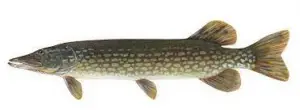 Introduced to Arizona in 1960’s, this lake holds good size northern pike.
Introduced to Arizona in 1960’s, this lake holds good size northern pike.
The average size of a pike in Arizona will be 1-3-pounds. Some can grow up to 30+pounds and live to nearly 20-years old!
Pike have a strong appetite. Their carnivorous habit, along with their massive size, might spell doom for other fish in a body of water. As a result, both Arizona State Parks and Trails and the Arizona Game and Fish Department request that fishermen keep all pike caught and do not return them to the lake. Fortunately, there is plenty of other fish in the lake right now, and the food chain hasn’t been disrupted.
Fast-moving lures that replicate other fish species are usually effective for pike. Baits that simulate rainbow trout are becoming increasingly popular at Fool Hollow, and they work well on larger fish.
For pike, don’t be afraid to toss lures that are 8″ to 10″ long. Their enormous toothy mouths regularly snag even larger fish, and an 8″ lure may appear to bigger pike as a simple mid-morning feast.
Big flutter spoons simulate wounded baitfish, spinnerbaits, large swimbaits, crankbaits, and big inline spinner lures all have a proven track record for catching pike.
The secret is to experiment with a variety of baits until you find one that works, and then stay with it until you no longer get strikes.
General Crappie Details
Spawn: March-May
Food: Baitfish, small game fish, crayfish, and worms. Small fish make up their main diet.
Arizona State Record: 32 lb. 5.6 oz. 49 in. Ashurst Lake Ronald Needs, Flagstaff 11/5/04
Table Quality: The meat is excellent. It’s firm, flaky and white.
Angling techniques:
Catfish
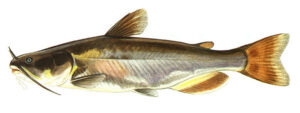
Channel catfish weight will range from 0.5-to-15-pounds in and of the Roosevelt chain lakes, including Canyon Lake. However, the average weight will be between 1-4-pounds.
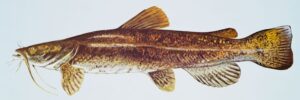
Conversely, “smaller” flathead catfish will weigh in at 15-pounds and can grow around 75-pounds. A flathead survey conducted in 2016 and 2020 caught a flathead that weighed over 48-pounds!
General Catfish Details
Spawn: March-June
Food: Carp, bluegill
Arizona State Record:
Channel catfish – 33 lb., 5.76 oz., 39.5 in., Upper Lake Mary Carson Pete, 3/26/17
Flathead catfish – 76 lb. 8.64 oz., 53.5 in., Bartlett Lake Eddie Wilcoxson, Surprise 04/13/13
Table Quality: Soft white meat. In the summer the meat will taste muddy.
Angling techniques:
Flathead catfish:
- live bait such as smaller carp, full sized bluegill, or tilapia
Channel catfish:
- chicken liver
- hotdogs
- stink bait
- small bluegill
- small carp
Bluegill/ Sunfish
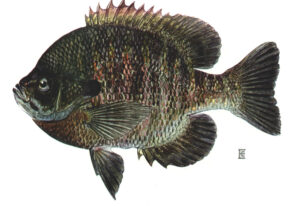 Introduced to Arizona in 1932, the bluegill has teal-blue coloring on the bottom portion of the chin and gill plate. It also has a solid black opercula flap just behind the gill plate.
Introduced to Arizona in 1932, the bluegill has teal-blue coloring on the bottom portion of the chin and gill plate. It also has a solid black opercula flap just behind the gill plate.
Bluegill are found on the shoreline and prefer nearby structures. Bluegill are incredibly aggressive and will quickly attack anything that looks like it could be eaten. Due to their aggressive behavior, they are one of the easiest fish to catch and are a great way to introduce someone to fishing.
Spawn: April and May
Food: Small fish and insects
Arizona State Record: 3 lb. 15.68 oz. 15.75 in., Goldwater Lake. Christopher Ray Mapes, Prescott Valley 5/2/04
Table Quality: Firm, white meat
Angling techniques:
- Worms
- Dough balls
- Slim jim sausages pieces on a small hook (not lying… it really works)
- Small spinners
- Trout flys
Boat Ramps At Kinnikinick Lake
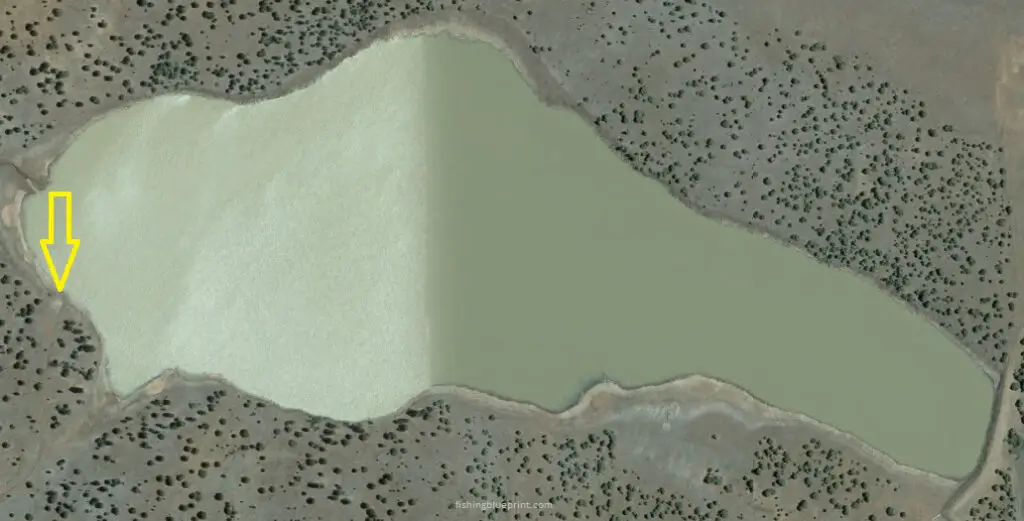
Look Closely…

There is no true boat ramp. however there is a primitive “ramp” area where you can dry launch a small aluminum boat, kayak, or float tube here.
Top Tackle Shops Near Kinnikinick Lake
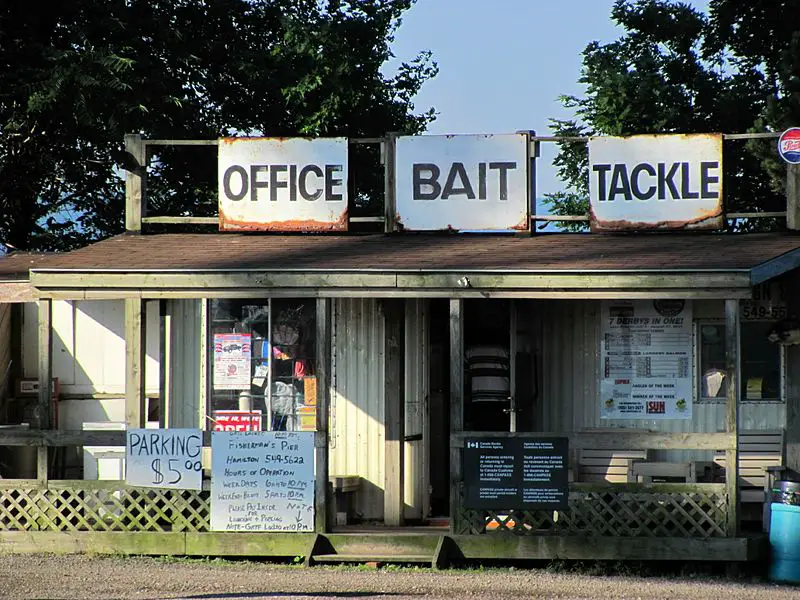
Lake Mary Country Store & T Park and Lake Mary Fishing Boat Rentals
- 8510 Lake Mary Rd, Flagstaff, AZ 86005
- (928) 774-1742
Big 5 Sporting
- 2775 S Woodlands Village Blvd, Flagstaff, AZ 86001
- (928) 214-0590
Sportsman’s Warehouse
- 2231 E Rte 66, Flagstaff, AZ 86004
- (928) 526-2300
REI
- 323 S Windsor Ln, Flagstaff, AZ 86001
- (928) 213-1914
Walmart
- 2750 S Woodlands Village Blvd, Flagstaff, AZ 86001
- (928) 773-1117
Places To Camp At Or Near Kinnikinick Lake
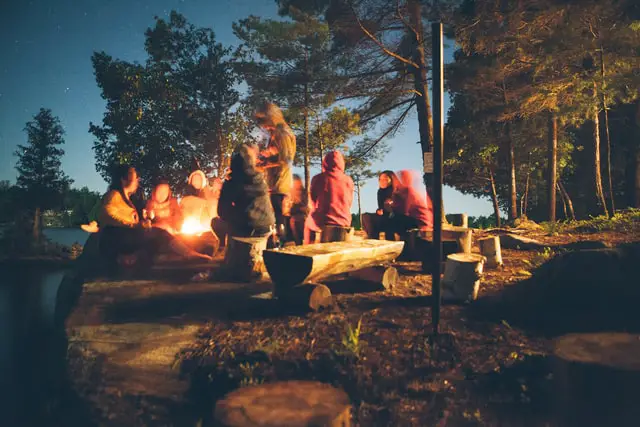
Ashurst Lake & Forked Pine Campgrounds
This campground is listed as a moderate/heavy use drive-in primitive campground off the dirt road. There are very few amenities provided. Everything else is – “Pack it in pack it out, and leave area clean for next occupant”.
Campground host: On site.
Quiet hours: 10 p.m. to 6 a.m. (running generators not permitted during quiet hours)
- Location: Forest Service Rd 82E, Flagstaff, AZ 86001
- Phone number: (928) 526-0866
- Nearby access to the lake: yes
- Tents, trailers and small motorhomes are allowed.
- Site quantity: 25 sites
- Low season: October – March
- High season: April – September
- Concrete pads: no
- Drinking water available: yes
- Rustic toilets.
- Pets welcome: yes
- Fire ring: yes
- Picnic table: yes
- Nearby gas: yes, several miles away
- Nearby place to buy firewood: yes, several miles away
- Nearby place to buy groceries: yes
- Campground map – click here
- Reservations – click here
Other Activities You Can Do Near Kinnikinick Lake
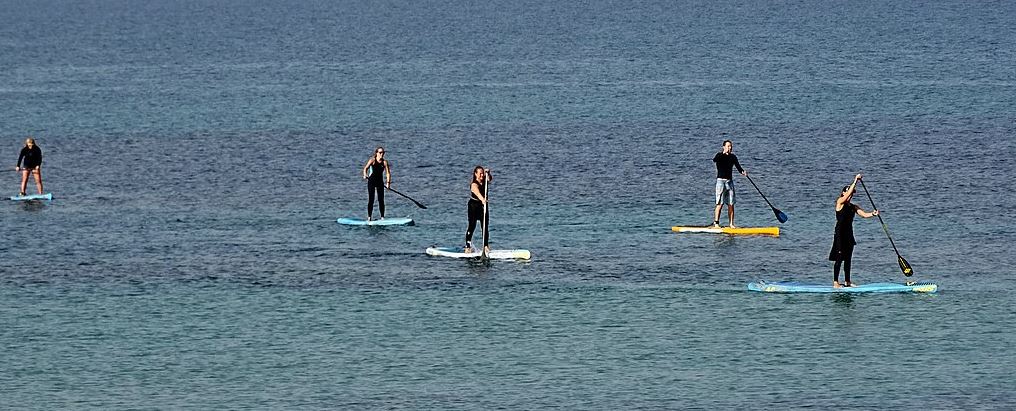
For those who want to chill at the lake…
- Biking
- Bird watching
- Boating
- Skiing
- Kayaking
- Canoeing
- Paddleboarding
- Sailing
- Swimming
- Camping
- Horseshoes
- Picnicking
- Hiking
- Gentle walking trails
- Nature photography trails
- Wildlife viewing
- Mountain biking
- Stargazing
- and most importantly… relaxing.
Other Arizona Related Fishing Articles
- Top 20 Best Places To Fish In Arizona 2023
- Interactive AZ Fishing Map 2023 – Where To Go Fishing In Arizona
- How much does a Arizona fishing license cost?
- Best Tackle Shops In Phoenix Arizona 2023
- Best Bass Fishing Lakes in Arizona 2023 (Voted by Local Anglers!)
- Alamo Lake Fishing Report 2025
- Apache Lake Fishing Report 2025
- Ashurst Lake Fishing Report 2025
- Bartlett Lake Fishing Report 2025
- Bear Canyon Lake Fishing Report 2025
- Big Lake Fishing Report 2025
- Blue Ridge Reservoir Fishing Report 2025
- Canyon Lake Fishing Report 2025
- Chevelon Lake Fishing Report 2025
- Kinnikinick Lake Fishing Report 2025
- Lake Havasu Fishing Report 2025
- Lake Mary Fishing Report 2025
- Lake Pleasant Fishing Report 2025
- Patagonia Lake Fishing Report 2025
- Rainbow Lake Fishing Report 2025
- Roosevelt Lake Fishing Report 2025
- Saguaro Lake Fishing Report 2025
- Show Low Lake Fishing Report 2025
- Sunrise Lake Fishing Report 2025
- Willow Springs Lake Fishing Report 2025
- Woods Canyon Lake Fishing Report 2025
More articles just for you...
Funny Fishing Rules, Laws, and Regulations 2025
Crazy Fishing Laws That Will Blow Your Mind! #7 is INSANE! Strange Fishing Regulations and Laws As silly as hook and rod limits may seem,
EXPOSED! How To Use A Spinnerbait The Right Way for 2025
Are You Wondering How To Use A Spinnerbait? Or How To Work A Spinnerbait Over Grass, Logs, or Points? Well, All These Questions Are Answered
EXPOSED! Best Crankbait Colors for 2025 [Which to Buy & Avoid]
What color crankbait to use? Crankbait Color Chart I just love going into a Bass Pro Shops store and just staring at all the walls
Best Underwater Dock Lights For Fishing – 2025 Buyers Guide
Night Dock Light Fishing For Beginners Dear fellow angler, Does this sound like you? You’re someone who loves fishing but just wants to escape the
15 Best Deep Diving Crankbaits [2025 Buyers Guide – Which to Buy & Avoid]
A Complete Buyer’s Blueprint On The Best Deep Diving Crankbaits for Bass, Walleye, or Striped Bass On The Market Today Fishing deep diving crankbaits can

